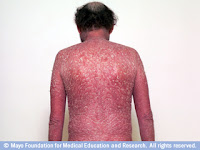Psoriasis patches can range from a few spots of dandruff-like scaling to major eruptions that cover large areas.
Though psoriasis signs and symptoms vary from person to person, psoriasis types are typically identified by their hallmark appearance. Here's a look at psoriasis pictures, showing classic signs and symptoms.
Plaque psoriasis
Plaque psoriasis, the most common form of psoriasis, causes dry, raised, red skin lesions (plaques) covered with silvery scales. The plaques itch or may be painful and can occur anywhere on your body. You may have just a few plaques or many, and in severe cases, the skin around your joints may crack and bleed.Lifestyle measures, such as using a nonprescription cortisone cream and exposing skin to small amounts of natural sunlight, may improve mild cases. Moderate or severe cases may require light therapy, prescription steroid creams, oral medications or a combination of these.
Scalp psoriasis
Scalp psoriasis appears as red, itchy areas with silvery-white scales. You may notice flakes of dead skin in your hair or on your shoulders, especially after scratching your scalp. The scaly patches, which may bleed when removed, may extend beyond your hairline.Treatment for scalp psoriasis includes medicated shampoo, steroid foam or lotion, and oral medications.
Nail psoriasis
Psoriasis can affect fingernails and toenails, causing pitting, abnormal nail growth and discoloration. Psoriatic nails may become loose and separate from the nail bed (onycholysis). Severe cases may cause the nail to crumble.Nail psoriasis often accompanies another type of psoriasis, such as plaque psoriasis. Treatment options include oral medications and light therapy.
Guttate psoriasis
Guttate psoriasis is usually triggered by a bacterial infection such as strep throat. It's marked by small, water-drop-shaped sores on your trunk, arms, legs and scalp. The sores are covered by a fine scale and aren't as thick as typical plaques are. You may have a single outbreak that goes away on its own, or you may have repeated episodes.Guttate psoriasis typically responds to treatment, which includes light therapy, prescription steroid creams and oral medications. It may also improve with treatment of the underlying cause or infection, if identified.
Inverse psoriasis
Inverse psoriasis causes smooth patches of red, inflamed skin primarily in the armpits, groin, under the breasts and around the genitals. Inverse psoriasis is more common in obese people and is worsened by friction and sweating.Treatment of inverse psoriasis may include taking a prescription oral medication.
Pustular psoriasis
Pustular psoriasis can occur in widespread patches or in smaller areas on your hands, fingertips or feet, as shown here. It can develop quickly, with pus-filled blisters appearing just hours after your skin becomes red and tender. The blisters dry within a day or two but may reappear every few days or weeks. The reaction can result from medications, an infection, severe irritation or light sensitivity.Small patches of pustular psoriasis may be treated with a steroid cream. Larger patches usually require prescription oral medication, elimination of the underlying cause, if possible, and other topical and systemic therapies. Light therapy may be useful once the blisters resolve and the skin is less irritated.
Erythrodermic psoriasis
Erythrodermic psoriasis, the least common type of psoriasis, can cover your entire body with a red, peeling rash that can itch or burn intensely. It may be triggered by corticosteroids or other medications, severe sunburn or sensitivity to light during phototherapy treatment, or by another type of psoriasis that's poorly controlled.Treatment of erythrodermic psoriasis usually requires prescription oral medication, medicated wet dressings and topical steroids. Combination therapies and hospitalization may be necessary for severe cases.








Penyakit psoriasis mungkin terdengar asing di telinga anda, tapi jangan anggap remeh temukan jawaban Psoriasis di tanyadok.com portal informasi layanan kesehatan untuk informasi lengkapnya
BalasHapus